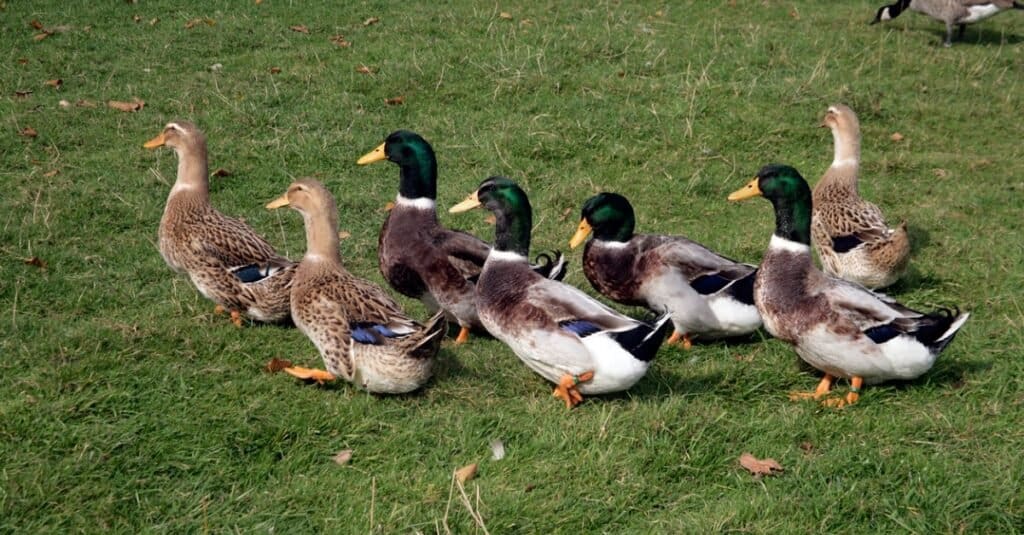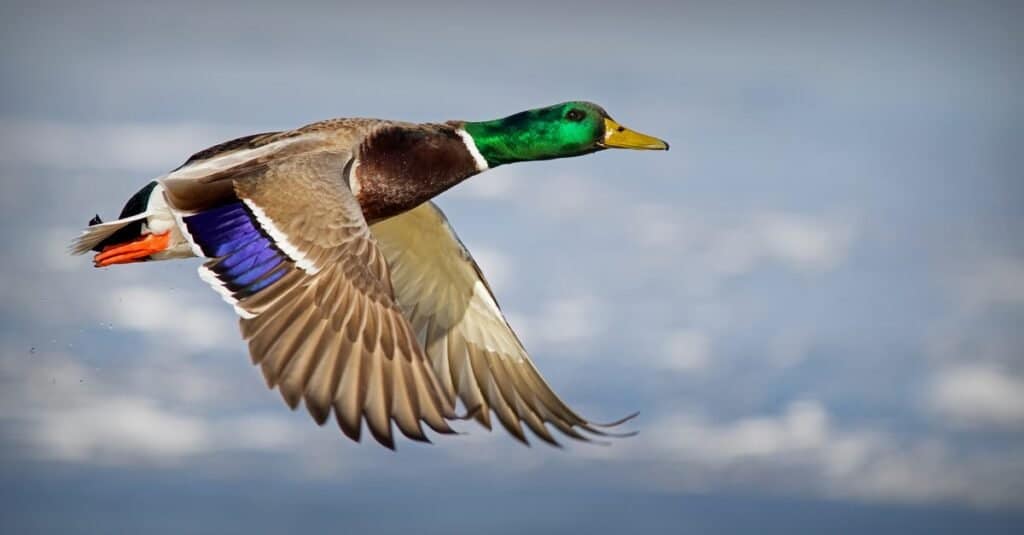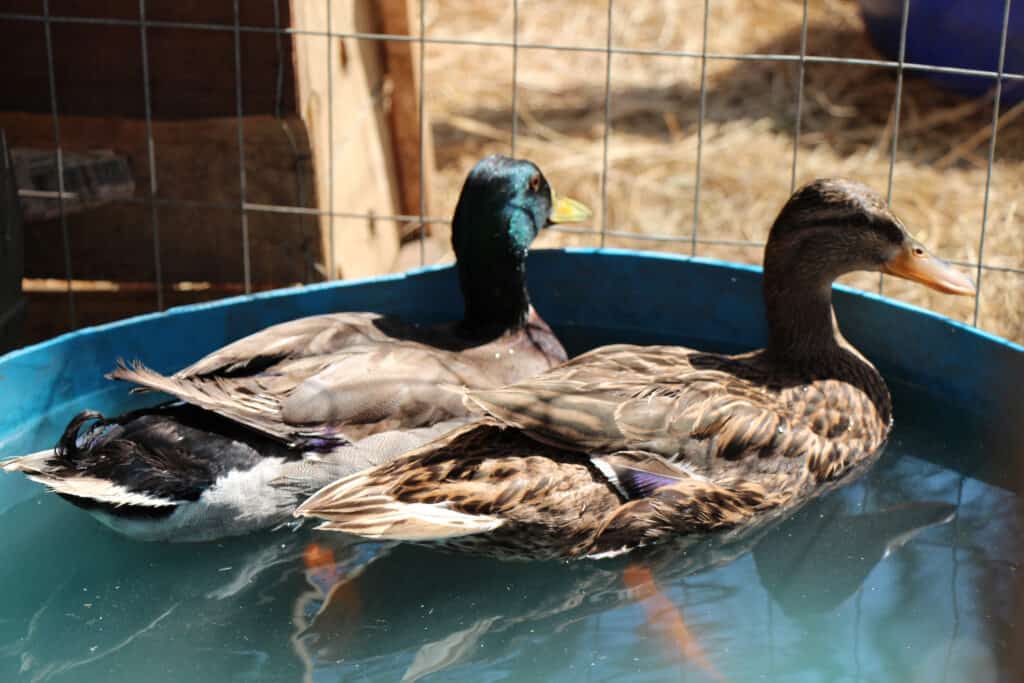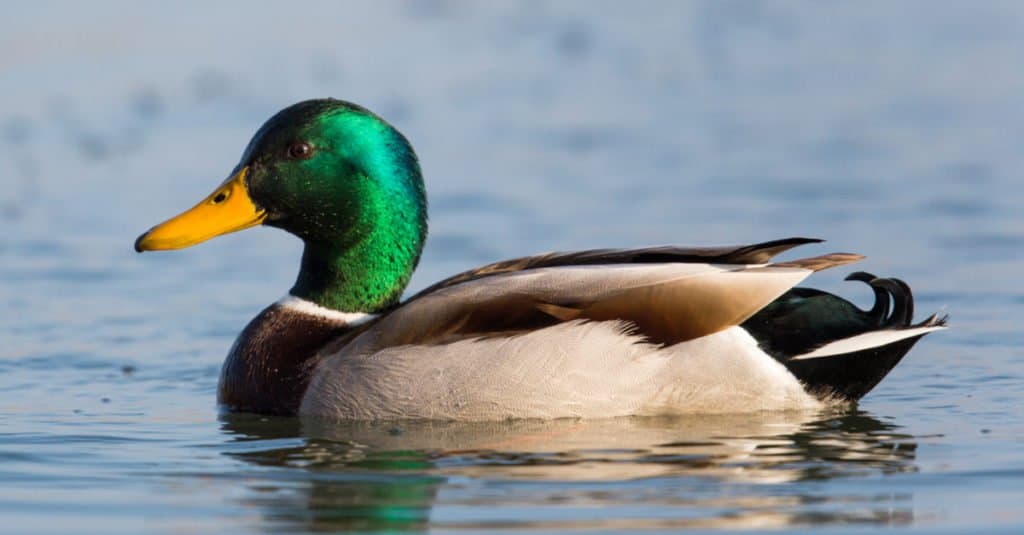Rouen ducks and mallards are often mistaken for the same duck. Well, that is not entirely wrong because they belong to one poultry family. The Rouen is a breed of domesticated duck that is mainly raised for exhibition, meat, decoration, or general-purpose ducks. The mallard is a dabbling duck from the subfamily Anatinae of the waterfowl family Anatidae.
Rouen ducks and mallards may look similar but differ in many ways. This article will address all the differences between the Rouen duck and mallard to help you distinguish between the two.
Comparing Rouen Duck vs Mallard

| Rouen Duck | Mallard | |
|---|---|---|
| Appearance | Rouen ducklings have two stripes running across the face | Mallard ducklings have one stripe running across the eye |
| Size | Weighs 6-8 pounds (2.7-3.6 kg) | Weighs 1.5-3.5 pounds (0.7-1.6 kg) |
| Domestication | Easier to tame | Difficult to tame |
| Temperament | Docile | Aggressive |
| Feeding habits | Primarily feed on larvae, aquatic animals, plant materials, crabs, and small fish | Mainly feed on insects, gastropods, worms, crustaceans, and plant matter |
| Origin | France | Europe, Asia, and North America |
| Life span | 8-12 years | 5-10 years |
| Egg clutches | 5-10 eggs per clutch | 8-13 eggs per clutch |
The Key Differences Between a Rouen Duck and a Mallard
Size and personality are significant differences between a Rouen duck and a mallard.
The Rouen duck is slightly heavier than the mallard. Unlike Rouen ducks, who tend to be calm when close to humans, mallards avoid humans at all costs. You will need a little effort to approach a mallard if you want to keep one at home.
Let’s go deeper into the major differences between Rouen ducks and mallards.
Rouen Duck vs Mallard: Appearance

Rouen ducks have brighter speculum feathers that are more extensive than those of mallards.
©iStock.com/MikeLane45
The plumage coloring of the Rouen duck is nearly identical to that of the mallard. However, female Rouen duck females have a much darker-brown plumage than female mallards. Rouen ducks also have brighter speculum feathers that are more extensive than the mallards.
The Rouen and mallard ducklings are also identical in terms of plumage coloring, though Rouen ducklings have two stripes running across their face, just under the eye. Mallard ducklings have only one stripe running across the eye.
Rouen Duck vs Mallard: Size

The mallard is a medium-sized waterfowl weighing between 1.5-3.5 pounds.
©Jeffry Weymier/Shutterstock.com
Rouen ducks are slightly heavier than mallards. The production variety of Rouen ducks weighs between 6-8 pounds (2.7-3.6 kg), though the standard-bred may weigh approximately 9-12 pounds (4.1-5.4 kg). The mallard is a medium-sized waterfowl weighing between 1.5-3.5 pounds (0.7-1.6 kg).
Both species also have striking differences in terms of body shape. Mallards have a rounded chest that makes their neck appear shorter, while Rouen’s chest looks downwards, making the Rouen ducks look like they have longer necks.
Rouen Duck vs Mallard: Domestication
As mentioned earlier, the Rouen ducks are mainly domesticated for meat, decoration, exhibition, and general-purpose ducks. Other people also keep Rouens mainly for their eggs. Rouens are more adaptable to humans than mallards since they are not from a wild duck race.
On the other hand, mallards are wild ducks and can be challenging to approach. Many people tame mallards because of their aesthetic feathers’ beauty, not industrial affairs. Mallards don’t thrive well in captivity as well. They prefer settling in a slightly wet place on the edge of the river or lake, where they will form a colony.
Rouen Duck vs Mallard: Temperament
Rouen ducks are well known for their docile personality, which is why humans domesticate them. Rouen ducks are very calm and easily approachable when close to humans. Mallards are best known for their aggressive behavior, plus they are a little elusive from humans, which is why they are a little more difficult to tame than Rouen ducks.
Rouen Duck vs Mallard: Feeding Habits

Rouen ducks feed primarily on larvae, pupae, snails, crabs, small fish, plant material, seeds, and aquatic animals.
©iStock.com/smrials
Rouen ducks and mallards don’t have much distinction in terms of food. Both species are omnivorous and very flexible in their choice of food. Rouen ducks feed primarily on larvae, pupae, snails, crabs, small fish, plant materials, seeds, and aquatic animals. However, most of the mallard’s diet consists of insects, worms, gastropods, crustaceans, seeds, and plant materials.
Rouen Duck vs Mallard: Origin
The Rouen duck originated in France before the 19th century. Prior to refinement, the French version of the Rouen duck was almost similar to a larger-than-average mallard. It was mainly domesticated as a roasting bird. In 1850, D.W. Lincoln of Worcester, Massachusetts, introduced the first Rouens to the United States, where they were initially used as general farm ducks before they became popular as show birds. They are now bred in captivity around many places worldwide.
The term mallard originally referred to any wild drake, derived from the Old French ‘malart’ or ‘mallart.’ Mallard ducks are native to Asia, Europe, and most parts of North America. They were among the many species of birds Carl Linnaeus initially described in the 1758 10th edition of Systema Naturae. Mallards have been introduced to several countries, including South Africa, Australia, Brazil, Peru, New Zealand, Colombia, Chile, Uruguay, Argentina, and the Falkland Islands.
Rouen Duck vs Mallard: Life Span

The average lifespan of mallards in the wild is between five to ten years.
©Pascal Halder/Shutterstock.com
The typical lifespan of the Rouen duck varies based on the purpose for which it is raised and the conditions in which it is raised. Rouen ducks can live for eight to twelve years if given the greatest possible care.
The average lifespan of mallards in the wild is between five to ten years. They can live more than ten years in captivity when given the best care accordingly. They only need water, lots of space to walk around, and food.
Are Mallards The Only Ducks That Quack?
The familiar “quack” often associated with ducks is typically the sound of a female mallard quacking, but many female dabbling ducks produce similar quacking noises. However, ducks have a range of other vocalizations in their repertoire.
The classic duck sound you hear is usually made by female mallards. They quack in a sequence of 2 to 10 quacks, starting loud and getting softer.
When they’re courting, females might use a paired version of this quack. Males, on the other hand, don’t quack; they produce a quieter, raspy call with just one or two notes.
Rouen Duck vs Mallard: Egg Clutches
The average clutch size in Rouen ducks is between five to ten white eggs, while mallards lay between 8-13 creamy white to greenish-buff eggs per clutch. After hatching, Rouen ducklings take more time to attain sexual maturity than mallard ducklings. Female mallards may take about seven to ten months to produce eggs. As youngsters, mallard’s development is relatively swift. Mallards reach sexual maturity between five and nine months.
The photo featured at the top of this post is © iStock.com/MikeLane45
Thank you for reading! Have some feedback for us? Contact the AZ Animals editorial team.






